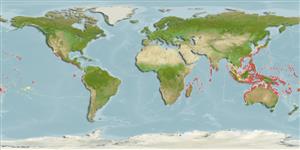Classification / Names
Common names from other countries
Main reference
Size / Weight / Age
Max length : 5.0 cm TL male/unsexed; (Ref. 2798)
Environment
Marine; reef-associated
Climate / Range
Tropical, preferred ?
Distribution
Short description
Dorsal
spines
(total): 7;
Dorsal
soft rays
(total): 9;
Anal
spines: 1;
Anal
soft rays: 8. Males uniformly dark brown; fins dusky to black (Ref. 2798). Females light brown with crossbars on body; caudal base with dark bar; dorsal and caudal fins mottled, other fins clear (Ref. 2798); characterized further by having upper 5-6 pectoral rays partly free of membrane; rounded caudal fin; longitudinal scale series 28-32; predorsal scales 9-13, not reaching rear margin of preopercle; cheek, opercle, pectoral fin base and prepelvic area without scales; ctenoid body scales, becoming cycloid on head and anterior body (short distance anterior to first dorsal fin); depressed head, width greater than depth; depth of body 4.6-5.9 in SL (Ref. 90102).
IUCN Red List Status (Ref. 115185)
Threat to humans
Harmless
Human uses
More information
Common namesSynonymsMetabolismPredatorsEcotoxicologyReproductionMaturitySpawningFecundityEggsEgg development
ReferencesAquacultureAquaculture profileStrainsGeneticsAllele frequenciesHeritabilityDiseasesProcessingMass conversion
Tools
Special reports
Download XML
Internet sources
Estimates of some properties based on models
Phylogenetic diversity index
PD50 = 0.5000 many relatives (e.g. carps) 0.5 - 2.0 few relatives (e.g. lungfishes)
Trophic Level
3.3 ±0.5 se; Based on size and trophs of closest relatives
Resilience
High, minimum population doubling time less than 15 months (Preliminary K or Fecundity.)
Vulnerability
Low vulnerability (11 of 100)
Price category
